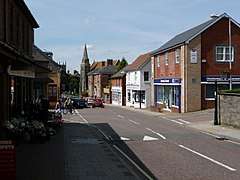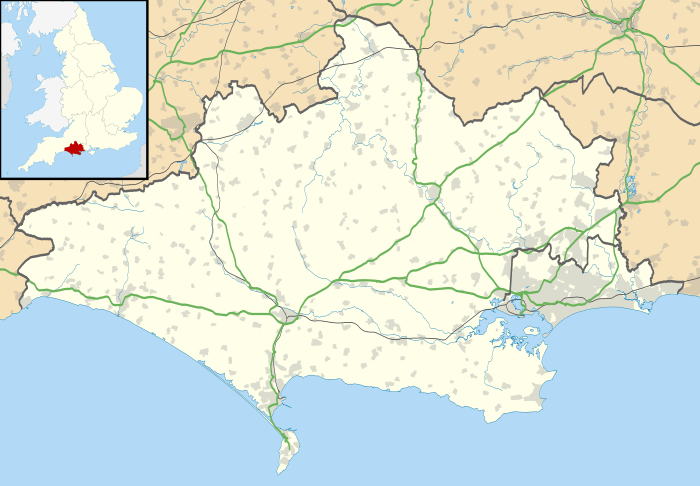Gillingham, Dorset
Gillingham (/ˈɡɪlɪŋəm/ (![]()
| Gillingham | |
|---|---|
 High Street, Gillingham | |
 Gillingham Location within Dorset | |
| Population | 11,756 [1] |
| OS grid reference | ST805265 |
| Civil parish |
|
| District | |
| Shire county | |
| Region | |
| Country | England |
| Sovereign state | United Kingdom |
| Post town | GILLINGHAM |
| Postcode district | SP8 |
| Dialling code | 01747 |
| Police | Dorset |
| Fire | Dorset and Wiltshire |
| Ambulance | South Western |
| UK Parliament |
|
Gillingham is pronounced with a hard initial 'g', unlike Gillingham, Kent, which is pronounced with a soft 'g'.
History
There is a Stone Age barrow[2] in the town, and evidence of Roman settlement in the 2nd and 3rd centuries; however the town was established by the Saxons. The church of St Mary the Virgin has a Saxon cross shaft dating from the 9th century.[3]
The name Gillingham was used for the town in its 10th century Saxon charter, and also in an entry for 1016 in the annals, as the location of a battle between Edmund Ironside and the Vikings. In the Domesday Book in 1086 it is recorded as Gelingeham,[4] and later spellings include Gellingeham in 1130, Gyllingeham in 1152 and Gilingeham in 1209. The name derives from a personal name plus the Old English inga and hām, and means a homestead of the family or followers of a man called Gylla.[4]
Half of the town's population of 2,000 died of the Black Death in the four months following October 1348.[5]
In the Middle Ages, Gillingham was the site of a royal hunting lodge, visited by Kings Henry I, Henry II, John and Henry III. A nearby royal forest, Gillingham Forest, was set aside for the king's deer. The lodge fell into disrepair and was destroyed in 1369 by Edward III.
Edward Rawson, the first secretary to the Massachusetts Bay Colony, was born in Gillingham.
Gillingham became a local farming centre, gained the first grammar school in Dorset in 1516 and a mill for silk in 1769. Gillingham's church has a 14th-century chancel, though most of the rest of the building was built in the 19th and 20th centuries. Many other buildings in the town are of Tudor origin.
In the 1820s, the artist John Constable stayed at Gillingham vicarage and, being impressed by the beauty of the countryside, executed several local sketches and paintings. His painting of the old town bridge is in the Tate Gallery.[6] In the 1850s, the arrival of the railway to the town brought prosperity and new industries including brickmaking, cheese production, printing, soap manufacture and at the end of the 19th century one of the first petrol engine plants in the country. In the Second World War Gillingham's position on the railway from London to Exeter was key to its rapid growth. In 1940 and 1941 there was large-scale evacuation of London and other industrial cities to rural towns, particularly in the north, southwest and Wales. Gillingham grew rapidly because of this..
Gillingham was the centre of a liberty of the same name.
Demography
In the 2011 census Gillingham civil parish had 5,345 dwellings,[7] 5,107 households and a population of 11,756.[1]
The population of the parish in the censuses between 1921 and 2011 is shown in the table below:
| Census Population of Gillingham Parish 1921—2011 (except 1941) | ||||||||||||||
|---|---|---|---|---|---|---|---|---|---|---|---|---|---|---|
| Census | 1921 | 1931 | 1951 | 1961 | 1971 | 1981 | 1991 | 2001 | 2011 | |||||
| Population | 3,294 | 3,274 | 3,352 | 3,619 | 4,050 | 5,440 | 6,740 | 9,340 | 11,756 | |||||
| Source:Dorset County Council[8] | ||||||||||||||
Governance
Gillingham is divided into four electoral wards: Gillingham Town, Lodbourne, Milton and Wyke. Their total population in the 2011 census was 9,799. They form part of the constituency of North Dorset, which is currently represented in the UK parliament by the Conservative Simon Hoare.[9]
Economy and society
Gillingham has good transport links, being 4 miles south of the A303, the main road from London to the South West, and having a railway station on the Exeter to London railway line. Salisbury is about 30 minutes away by train, and 50 minutes by car. It is approximately two hours into central London, with trains arriving at Waterloo.
The town has 70 shops and two commercial estates (Brickfields Business Park and Brickfields Industrial Estate) and the Gillingham education area has 7 primary schools (4 in the town) and 1 secondary school.
The town plays host to the annual 'Gillingham & Shaftesbury Show', which is an agricultural show held every August at the showground on the outskirts of the town. Gillingham Town Carnival is held every October.
Gillingham has a Non-League football club, Gillingham Town F.C., who play at Harding's Lane, and a rugby union club. Until 2009, when it ceased for financial reasons, Gillingham hosted an annual 10-day festival of music and sport. Gillingham has had a brass band since 1928; they are currently nationally graded in the 3rd Section, and perform at civic events and carnivals. Gillingham has the only night club in North Dorset.
See also
References
- "Area: Gillingham (Parish), Key Figures for 2011 Census: Key Statistics". Neighbourhood Statistics. Office for National Statistics. Retrieved 28 July 2014.
- "The Dorset Page's Gillingham Page". Archived from the original on 28 August 2008. Retrieved 23 July 2003.
- St Mary the Virgin
- David Mills, ed. (2011). A Dictionary of British Place Names. Oxford University Press. p. 203. ISBN 978-0-19-960908-6.
- Times 1/2/07 Simon de Bruxelles Lost documents shed light on Black Death
- Gillingham Through Time. Amberley Publishing Archived 11 August 2014 at the Wayback Machine
- "Area: Gillingham (Parish), Dwellings, Household Spaces and Accommodation Type, 2011 (KS401EW)". Neighbourhood Statistics. Office for National Statistics. Retrieved 28 July 2014.
- "Parishes (A-L), 1921-2001- Census Years". Dorset County Council. 27 May 2014. Retrieved 28 July 2014.
- "Dorset North Parliamentary constituency". Election 2015. BBC. Retrieved 10 May 2015.
Further reading
Porter, John (2013). Gillingham's royal forest : the medieval centuries. Gillingham: Gillingham Museum. ISBN 9780992706302.
External links
| Wikimedia Commons has media related to Gillingham, Dorset. |
